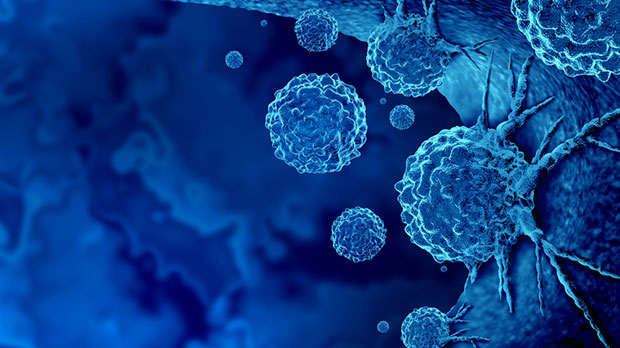
When a cancer spreads from a primary tumour, the place where it first started to grow, to another area of the body, this is referred to as metastasis.
To spread, some cells from a primary tumour need to break away and travel to another place in the body via the bloodstream. These cells then form another tumour, called a secondary tumour, in another organ.
For example, breast cancer cells may travel to the lungs and form a secondary tumour there.
Metastasis is associated with very poor prognosis, and despite being the main cause of death in people with cancer, it has remained incredibly difficult to prevent and treat. This is largely because we haven’t been able to identify key drivers of this process that could act as therapeutic targets. Until now.
Ground-breaking research from scientists at our Cambridge Institute, recently published in Nature Genetics, has identified a protein in our cells, called NALCN, as a key regulator of metastasis.
What’s more, their findings show us that metastasis isn’t a process unique to cancer cells. Instead, cancer cells exploit a process that healthy tissues use to shed cells and move around the body, revolutionising the way we think about metastasis.
These findings are among the most important to have come out of my lab for three decades. Not only have we identified one of the elusive drivers of metastasis, but we have also turned a commonly held understanding of this on its head, showing how cancer hijacks this process in healthy cells for its own gains.
Professor Richard Gilbertson
Finding the right channel
In their previous research, the team had identified a gene that was ‘turned off’ when a normal stem cell became a malignant stem cell in stomach cancers.
That gene makes the protein NALCN, which is a channel in the membrane of our cells that lets tiny molecules of salt pass in and out of them. The mutations caused the channel to be blocked off so it can’t perform its usual function.
This was unexpected, as the normal function of NALCN seemed to have no bearing otherwise on cancer development or progression.
So, in their most recent study they tested the effect of switching off this gene in mice with gastrointestinal cancers.
What they found was that losing the function of this gene had no effect on the primary tumour, but it caused the cancer to become extremely metastatic.
To investigate this phenomenon further, they switched the gene off in mice without cancer. And that’s where things got more interesting.
In these mice that had no NALCN, they found that healthy cells were metastasising around the body at a level similar to that of tumour cells in the mice with cancer.
Crucially, when these circulating cells reached another organ, they formed normal tissue in that organ. For example, if cells that had shed from the stomach had moved to the kidney, they turned into normal kidney cells.
“Traditionally, we think about our organs a bit like houses in a street, and those houses never share bricks with each other throughout life,” says Professor Richard Gilbertson, senior group leader at our Cambridge Institute.
“What this opens the possibility for is that organs can actually share their cells with each other.
“In fact, we see this at low rates going on all the time, even when we don’t delete this channel, suggesting that organs actually are much more fluid than we used to think.”
It may be that the body is therefore using this process as a repair mechanism. If some of the cells in one organ are damaged, cells from other organs can be mobilised to replace them.
This is the first time it’s been shown that metastasis is in fact a normal process, and it’s not only cancer cells that can spread around the body, a belief that’s been held for decades.
Solving the mysteries
In addition to elucidating the mechanism of metastasis, these findings might help to explain other current mysteries surrounding metastasis. For example, secondary tumours can appear in a person that had their primary tumour removed many years earlier or, in very rare cases, never had a primary tumour.
In these cases, it may be that healthy cells acquired some cancer-causing mutations but did not develop into cancer at their primary location. These ‘normal’ cells then shed from their original site, and move to other organs, where they formed normal tissue.
These cells then go on to become cancerous in the future after accumulating more mutations, creating metastases even though a primary tumour has been removed, or never formed in the tissue they originally came from.
And on the flipside, it provides an explanation as to why, for many years, dormant circulating tumour cells (CTCs) have been observed in people with cancer that have not gone on to form secondary tumours, which raised the question of why some CTCs form tumours and others don’t.
It’s because these circulating cells aren’t actually tumour cells, they’re cells from healthy tissues, we just didn’t know they could circulate before now.
“We’ve been tied to the concept that this has to be abnormal, therefore, they have to be cancer cells,” says Gilbertson. “But now we know that isn’t the case. They’re not tumour cells, they’re actually part of this normal process.”
Opening the possibilities
Having identified the driver of metastasis, we now have a potential therapeutic target for preventing it, which has huge implications for cancer survival.
The team are therefore looking into ways to restore the function of NALCN in cancer cells to prevent metastasis from occurring.
This might be tricky, as drugs that target this type of channel usually aim to block them, rather than hold them open. However, it has been achieved before in drugs used to treat other conditions like cystic fibrosis, and the team are investigating whether there are existing drugs that could be repurposed to prevent metastasis.
But that isn’t the only implication of this research.
“We’ve got lots of different avenues to explore,” says Dr Eric Rahrmann, lead researcher on the study and senior research associate at our Cambridge Institute.
“Can we use the mutations in this gene as a diagnostic marker? Like an early detection approach. Can we make predictions on whether people will have metastatic disease?
“We’re also looking at regenerative therapy medicines. If we enhance dissemination of cells from one organ to go into another organ to repair it, can we use this more as a truly reparative mechanism?”
This discovery has the potential to truly change the research landscape, both in the field of cancer research and beyond.
“If you could stop metastasis,” Gilbertson concludes. “Or significantly suppress it, you’re getting towards managing cancer for the long term, and that’s the Holy Grail.”
Jacob






